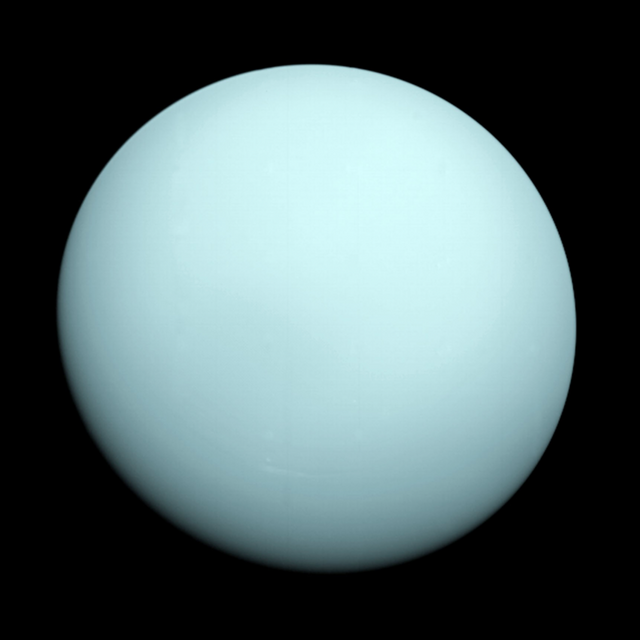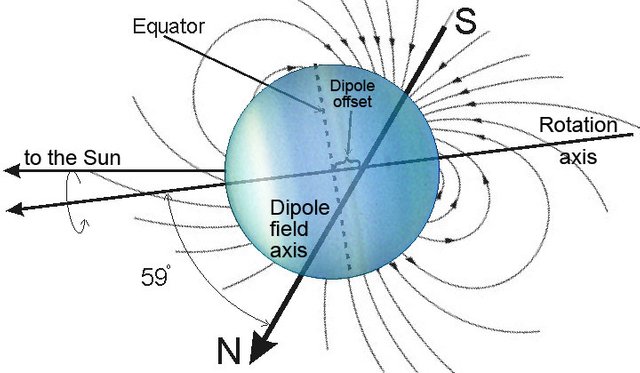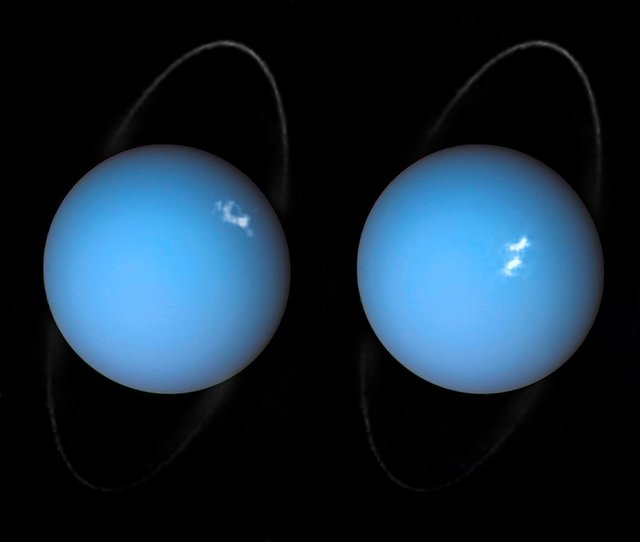Voyager-2 flied by Uranus on January 24, 1986 within 81 000 kilometers of cloud tops. More than 30 years after, researchers are using its data to learn more about the ice giant. With additional data obtained by Hubble Telescope researchers revealed strange and chaotic magnetosphere surrounding ice giant.
New study suggests that Uranus' magnetosphere, the region controlled by the planet's magnetic field and charged particles trapped inside it, gets flipped on and off like a light switch every day as it rotates along with the planet. It's "open" in one orientation, allowing solar wind to flow into the magnetosphere; it later closes, forming a shield against the solar wind and deflecting it away from the planet.
Blasts of solar wind form strong auroras on the surface, spotted by Hubble. By watching the auroras over time, astronomers collected the first direct evidence that these powerful shimmering regions rotate with the planet. They also re-discovered Uranus' long-lost magnetic poles, which were lost shortly after their discovery by Voyager 2 in 1986 due to uncertainties in measurements and the featureless planet surface.

Image: NASA/JPL - Image taken by Voyager-2
Earth's magnetic field is nearly aligned with its spin axis, causing the entire magnetosphere to spin like a top along with the Earth's rotation. It protects us from charged particles, deflecting them along the strands, which form closed loops and only during strong solar storms can break and close again. These magnetic reconnection results in polar auroras.
Magnetic field of Uranus is mad because its rotating axis is tilted abouit 90 degrees to the Solar System's plane - it rotates on the side.

Image: Wikimedia magnetic compass on the Uranus would be absolutely unusable.
Carol Paty, the Georgia Tech associate professor who co-authored the study says:
Uranus is a geometric nightmare. The magnetic field tumbles very fast, like a child cartwheeling down a hill head over heels. When the magnetized solar wind meets this tumbling field in the right way, it can reconnect and Uranus' magnetosphere goes from open to closed to open on a daily basis.
Auroras, spotted by Hubble, occure on Uranus in various places. The Georgia Tech researchers used numerical models to simulate the planet's global magnetosphere and to predict favorable reconnection locations. They plugged in data collected by Voyager 2 during its five-day flyby in 1986.

Image: ESA/Hubble & NASA, L. Lamy/Observatoire de Paris Composite image of Uranus and two Hubble obserbations. Rings system and auroras in the unexpected areas are seen
Learning more about Uranus is one of the keys to discovering more about planets beyond our solar system. Icy giants are very common among exoplanets. Besides, knoledge about Uranus' magnetosphere will help to design protection from radiation for new probes. There are a good chances that new mission will be sent to Uranus in 2027 - 2029.
Source: https://phys.org/news/2017-06-topsy-turvy-motion-effect-uranus.html
Very interesting discovery. Just shows how lucky earth is to have everything aligned perfectly to maintain an enviroment for life. Thanks :)
Downvoting a post can decrease pending rewards and make it less visible. Common reasons:
Submit
Thank you for reading
Downvoting a post can decrease pending rewards and make it less visible. Common reasons:
Submit
Still there is more to be discovered in our solar system. Thanks for the article.
Downvoting a post can decrease pending rewards and make it less visible. Common reasons:
Submit
Very interesting!!!
Ive always loved space..
I cant believe Uranus's magnetic field rotates on its side, thats nuts!!
Still learning about our universe and planets
I feel like we know so little...
This was a great post!!!
Downvoting a post can decrease pending rewards and make it less visible. Common reasons:
Submit
Interesting! I remember seeing those images long ago and always thought they where white puffy clouds. So much interesting stuff in our back yard, relatively speaking.
Downvoting a post can decrease pending rewards and make it less visible. Common reasons:
Submit
haha me too!
Downvoting a post can decrease pending rewards and make it less visible. Common reasons:
Submit
It's kind of funny the more we learn about the solar system shows us how little we actually know.
Downvoting a post can decrease pending rewards and make it less visible. Common reasons:
Submit